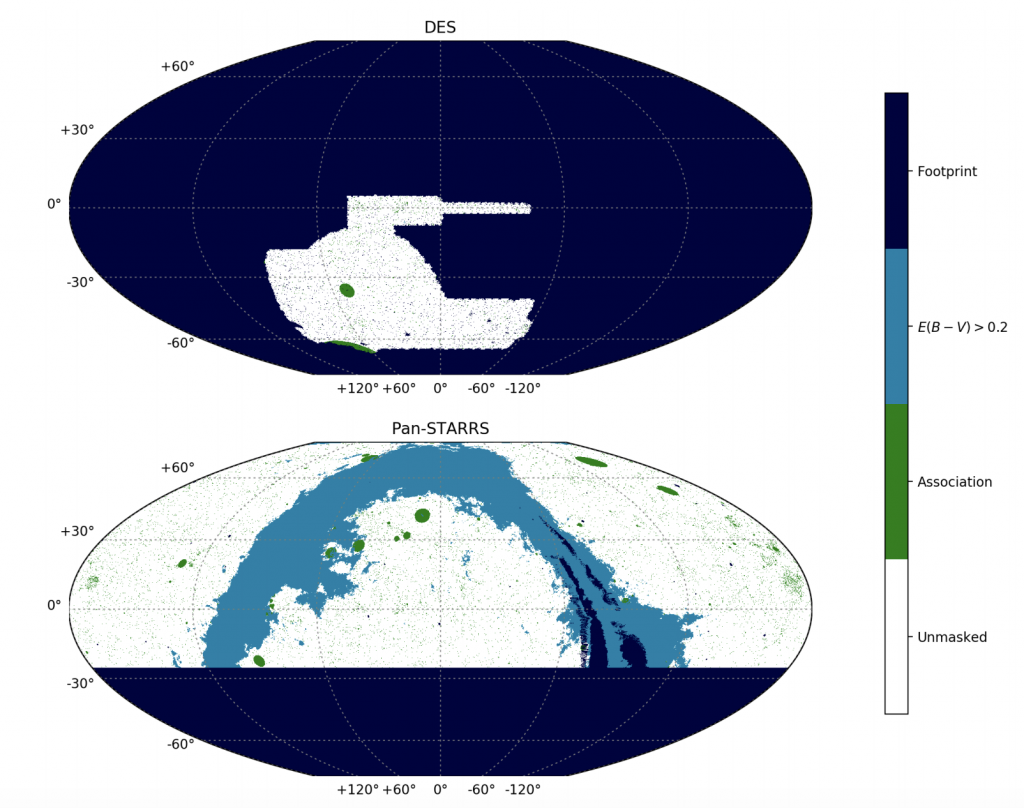This story was adapted from one originally published by Nathan Collins at SLAC. Read the original version here.
Just as the sun has planets and the planets have moons, our galaxy has satellite galaxies, and some of those might have smaller satellite galaxies of their own. To wit, the Large Magellanic Cloud (LMC), a relatively large satellite galaxy visible from the southern hemisphere, is thought to have brought at least six of its own satellite galaxies with it when it first approached the Milky Way, based on recent measurements from the European Space Agency’s Gaia mission.
Astrophysicists believe that dark matter is responsible for much of that structure, and now researchers with the Dark Energy Survey — including University of Wisconsin–Madison assistant professor of physics Keith Bechtol and his research group — have drawn on observations of faint galaxies around the Milky Way to place tighter constraints on the connection between the size and structure of galaxies and the dark matter halos that surround them. At the same time, they have found more evidence for the existence of LMC satellite galaxies and made a new prediction: If the scientists’ models are correct, the Milky Way should have an additional 150 or more very faint satellite galaxies awaiting discovery by next-generation projects such as the Vera C. Rubin Observatory’s Legacy Survey of Space and Time.

Two new studies, forthcoming in the Astrophysical Journal and available as preprints (pre-print 1; pre-print 2), are part of a larger effort to understand how dark matter works on scales smaller than our galaxy.
“The ultra-faint galaxies that orbit the Milky Way are small clouds of dark matter with just enough stars to see that they exist. They are nearly invisible, but if spotted, they make excellent natural laboratories to study dark matter,” Bechtol says. “We hope to learn what dark matter is made of, how it was produced in the early Universe, and what relationship it has to the known particle species.”
Shining galaxies’ light on dark matter
Astronomers have long known the Milky Way has satellite galaxies, including the Large Magellanic Cloud, which can be seen by the naked eye from the southern hemisphere, but the number was thought to be around just a dozen or so until around the year 2000. Since then, the number of observed satellite galaxies has risen dramatically. Thanks to the Sloan Digital Sky Survey and more recent discoveries by projects including the Dark Energy Survey (DES), the number of known satellite galaxies has climbed to about 60.
Such discoveries are always exciting, but what’s perhaps most exciting is what the data could tell us about the cosmos. “For the first time, we can look for these satellite galaxies across about three-quarters of the sky, and that’s really important to several different ways of learning about dark matter and galaxy formation,” said Risa Wechsler, director of the Kavli Institute for Particle Astrophysics and Cosmology (KIPAC). Last year, for example, the DES team used data on satellite galaxies in conjunction with computer simulations to place much tighter limits on dark matter’s interactions with ordinary matter.
Now, the team is using data from a comprehensive search over most of the sky to ask different questions, including how much dark matter it takes to form a galaxy, how many satellite galaxies we should expect to find around the Milky Way and whether galaxies can bring their own satellites into orbit around our own – a key prediction of the most popular model of dark matter.
Hints of galactic hierarchy
The answer to that last question appears to be a resounding “yes.”
The possibility of detecting a hierarchy of satellite galaxies first arose some years back when DES detected more satellite galaxies in the vicinity of the Large Magellanic Cloud than they would have expected if those satellites were randomly distributed throughout the sky. More data was needed to conclusively attribute this excess to galaxies that arrived at the Milky Way with the Large Magellanic Cloud.

In the first published study, the DES group combined observations from DES with those from the Pan-STARRS survey, together covering 75% of the sky, to test this hypothesis. The DES data represents nearly 40,000 images from a 500-million-pixel camera collected over three years from a telescope in Chile.
The raw DES data was run through a series of data compressions, including a final step led by Bechtol’s group, to identify and catalog individual stars, including their color, which infers temperature, and how far away they are.
“We throw the star catalog into our search algorithms, which are responsible for identifying small groups of stars that are clustered in space and have similar colors and brightness. There’s a particular distribution for what we expect the stars to look like in ultrafaint galaxies,” says UW-Madison physics graduate student Mitch McNanna. “Even then we’re not 100 percent sure that we’ve found a real galaxy, so we also collect spectroscopic observations to measure the doppler motion of the stars. Hopefully we see the group of stars is moving in a way that’s different from the rest of the stars in the Milky Way halo.”
The team, including Alex Drlica-Wagner at Fermilab, produced a model of which satellite galaxies are most likely to be seen by current surveys, given where they are in the sky as well as their brightness, size and distance.
In the second study, led by others in the DES team including Ethan Nadler at Stanford University and collaborators, the team took the findings of the latest satellite census and analyzed computer simulations of millions of possible universes. Those simulations model the formation of dark matter structure that permeates the Milky Way, including details such as smaller dark matter clumps within the Milky Way that are expected to host satellite galaxies. To connect dark matter to galaxy formation, the researchers used a flexible model that allows them to account for uncertainties in the current understanding of galaxy formation, including the relationship between galaxies’ brightness and the mass of dark matter clumps within which they form.
Those components in hand, the team ran their model with a wide range of parameters and searched for simulations in which LMC-like objects fell into the gravitational pull of a Milky Way-like galaxy. By comparing those cases with galactic observations, they could infer a range of astrophysical parameters, including how many satellite galaxies should have tagged along with the LMC. The results were consistent with Gaia observations: Six satellite galaxies should currently be detected in the vicinity of the LMC, moving with roughly the right velocities and in roughly the same places as astronomers had previously observed. The simulations also suggested that the LMC first approached the Milky Way about 2.2 billion years ago, consistent with high-precision measurements of the motion of the LMC from the Hubble Space Telescope.
Galaxies yet unseen
In addition to the LMC findings, the team also put limits on the connection between dark matter halos and galaxy structure. For example, in simulations that most closely matched the history of the Milky Way and the LMC, the smallest galaxies astronomers could currently observe should have stars with a combined mass of around a hundred suns, and about a million times as much dark matter. According to an extrapolation of the model, the faintest galaxies that could ever be observed could form in halos up to a hundred times less massive than that.
And there could be more discoveries to come: If the simulations are correct, there are around 150 more satellite galaxies – more than double the number already discovered – hovering around the Milky Way. The discovery of those galaxies would help confirm the researchers’ model of the links between dark matter and galaxy formation, and likely place tighter constraints on the nature of dark matter itself.